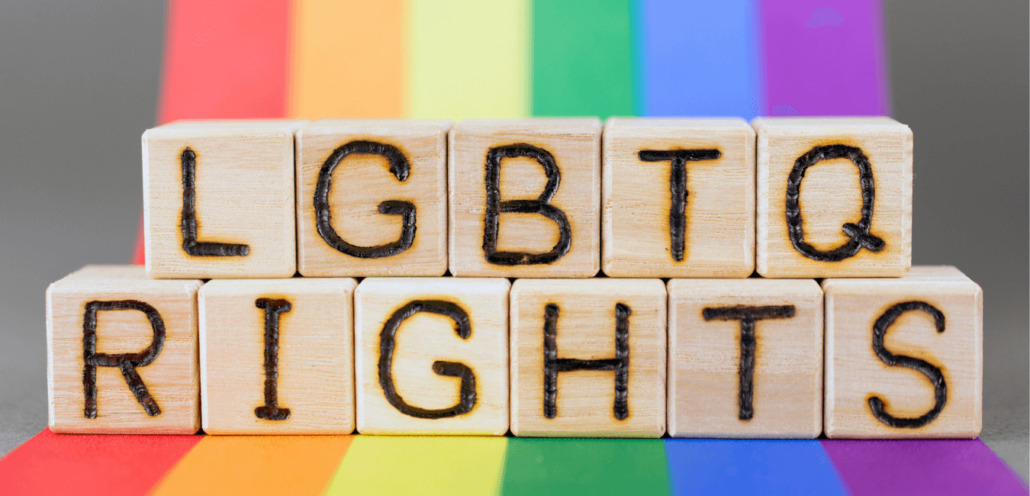Even with recent societal and legal changes that have granted more protections, LGBTQ+ people still face many unique financial (and non-financial) challenges. It’s a major reason why the team at Thinking Big is particularly passionate about helping clients manage their finances so that they can achieve their goals and live fulfilling, happy lives. It’s important to acknowledge that the LGBTQ+ community faces systemic issues, brought on from a long history of discrimination, that can get in the way of that success, especially for those who are also people of color.
Defining and acknowledging these issues helps us strategize and plan effectively in the face of obstacles. This special Pride Month post gives an overview of the unique financial challenges that LGBTQ+ people face, some of them due to a history of discrimination against the LGBTQ+ community, and others that simply are a part of being an LGBTQ+ person. We’re hoping you learn a bit more about LGBTQ+ finances!
A History of LGBTQ+ Discrimination
There’s a long history of LGBTQ+ discrimination in the United States, and it’s only been within the last 50 years that much of the change and progress occurred in advancing LGBTQ+ rights. It wasn’t until 2015 that same-sex marriage was legalized in all 50 states, and it wasn’t until 2020 that the Supreme Court ruled barring discrimination against LGBTQ+ people in employment decisions.
Many members of LGBTQ+ communities are still impacted by the long period of time spent without these rights and protections, and the financial strains have ripple effects starting at the individual level and spreading across communities. Research by Center for LGBTQ Economic Advancement and Research (CLEAR) found discrimination in the workplace has resulted in LGBTQ people being paid less than their heterosexual counterparts, contributing to the LGBTQ wealth gap. Discriminatory treatment from businesses, credit lenders, and housing services have caused LGBTQ people to be more likely to overpay for mortgages, experience unfair and deceptive marketing practices, and even be denied a home mortgage altogether.
LGBTQ+ Marriage
The right to marry drastically changed the financial landscape for LGBTQ+ people. Within only five years of the Supreme Court ruling in 2015 to legalize same-sex marriage, roughly 293,000 same-sex couples had married. As a result of these recent changes, the majority of same-sex married couples today now enjoy over 1,100 benefits and privileges by federal law that were previously only available to heterosexual couples. The federal benefits available to married couples provide a number of key financial benefits:
Health Insurance
LGBTQ+ married couples with employee-sponsored health plans can now weigh the financial and coverage benefits of each plan, and choose the one that best suits them. Additionally, they can access a special enrollment period under the ACA, if they want to get insurance that way. They also qualify for the Family Medical Leave Act, which allows eligible employees to take up to 12 weeks of unpaid leave in the event of a birth, adoption or foster care, or caring for immediate family members. Married couples also have visitation rights for hospital or prison stays and can make medical decisions more easily.
Social Security
LGBTQ+ married couples are entitled to receive Social Security retirement, survivor, and disability benefits. Children and step-children may also be eligible depending on their relationship to the worker.
Tax Filing
LGBTQ+ married couples can file taxes jointly, which helps them avoid separate filing fees, and take advantage of the marriage tax bonus if combining incomes keeps them in a corresponding tax bracket.
Gift (or Estate) Tax Exemptions
LGBTQ+ married couples are exempt from the gift tax, regardless of the amount of assets you transfer to your spouse.
Property Ownership
This is a benefit for couples who have been together for a long time (as much appreciation usually takes a lot of time). LGBTQ+ spouses are exempt from paying estate tax or any inheritance tax when inheriting property from each other. Additionally, when spouses sell a home, they won’t pay any taxes on any capital gains up to $500,000, provided they’ve lived there for at least two out of the five years prior to the sell date.
For more info on the ins and outs of marriage, Elizabeth Schwartz’s book, Before I Do, is a great resource for same-sex (and heterosexual) couples who are navigating the complex legal considerations of getting married. Especially because this institution is so new to the LGBTQ+ community and the landscape is still evolving (such as adoption rules), it’s important that same-sex couples understand the legal and financial implications of marriage, especially as it pertains to protecting your goals for the partnership and the legacy you want to build together.
LGBTQ+ and Family Planning
The financial considerations for starting a family are especially important for LGBTQ couples, who often must take alternative paths, like adoption or surrogacy, to have children. The costs can be high and vary widely.
Adoption
The total cost of adoption can be between less than $5,000 to $50,000 depending on the type of adoption. Foster care adoptions are almost completely free while international adoptions can be $20,000 to $50,000 depending on the country. Read more about LGBTQ adoption on our blog.
Surrogacy
The total costs of surrogacy can be between $100,000-150,000+.. These include in-vitro fertilization costs, the agency fees (the fee you pay to the agency for their coordination, medical screening, matching you with a surrogate, the fee to the surrogate (their pay for carrying the baby), legal costs to complete the surrogacy contract, the surrogate’s insurance, and all the other little costs that might be there (out of pocket medical, medications, lost wages if bedrest is required, etc.). Read more about surrogacy for same-sex couples on our blog.
IUI / Fertility Treatments
The cost for IUI includes donor sperm and the procedure itself and averages about $300 to $1,000 on average per cycle (but could be up to $4k) plus the donor sperm. The price range for IUI could be somewhere from $1,000 to $15,000 to get pregnant. Read more about fertility costs and procedures on our blog.
LGBTQ+ Student Loan Debt
Paying for college is already difficult enough as it is, but for LGBTQ+ students, it can be even more so because many have the additional barrier of not receiving parental support or guidance. A 2019 survey from Student Loan Hero found that 60% of LGBTQ+ individuals reported a lack of support from their families. A lack of family support can be exacerbated by the fact that most students are required to fill out the FAFSA (Free Application for Federal Student Aid), which also requires a parent signature, in order to apply for things like federal student loans, scholarships, grants, and work-study programs. Without the ability to file the FAFSA, students are unable to receive federal student loans, which have the most favorable borrowing terms; and as a result, a student may have to apply for private loans or use credit cards to cover the cost of college, making it much more expensive to borrow.
The survey also found that LGBTQ+ respondents on average had $112,607 in student loan debt, about $16,000 more than the general population average of $96,211. On top of that, those same LGBTQ+ borrowers were found to be more likely than the general population to make less than $50,000 a year. Wage gaps and workplace discrimination further adds to the challenges that LGBTQ+ people have with paying for college.

LGBTQ+ Insurance Issues
Like the fight for marriage equality, LGBTQ+ people have a long history of struggling to get the right healthcare. The history of discrimination and stigma against LGBTQ+ communities also intersects with a lack of training and competency of healthcare professionals to care for LGBTQ+ people. For instance, it wasn’t until 1987 that the American Psychiatric Association stopped classifying homosexuality as a mental illness.
Today, many LGBTQ+ people are hesitant to seek out medical care, for fear of being discriminated against, which puts them at greater risk for depression, anxiety, and various diseases. This fear is well justified. A survey by Lambda Legal showed that more than half of those who identified as LGB reported being discriminated against, and nearly a third of transgender respondents said they were outright denied care.
Aside from the challenge of finding healthcare professionals who understand their specific needs, health coverage is already prohibitively expensive, especially for many LGBTQ+ people. For example, gay men, particularly those with HIV, face serious hurdles in getting life, disability, or long-term care insurance, leaving them exposed to further financial risks as health conditions change and potentially deteriorate. Also, same-sex couples who historically were not able to marry would have to pay taxes on any health coverage they managed to receive through a domestic partnership.
Even though health insurance providers recently began to cover gender-affirming surgeries and hormone treatments, transgender people can still be denied access to them if they are deemed “cosmetic” (such as facial feminization or masculinization surgery). If a transgender person doesn’t have health insurance or the proper coverage, they can pay $100,00 or more in out-of-pocket expenses, not including necessities like on-going medical care, therapy, binders, hair removal, or gender-affirming clothing. This is just to be who they are, improve their mental health outlook, and protect themselves from anti-trans violence.
The fight for equal protections in this area continues, with hopes that the 2021 Equality Act will put legislation in place to protect LGBTQ+ healthcare rights.
LGBTQ+ Retirement
An extensive study done by Prudential on the financial experiences of LGBTQ+ people found that members of LGBTQ+ communities have less saved for retirement, on average, than their heterosexual counterparts. Specifically, the study found that LGBTQ+ people are less likely to have 401k savings and to save less of their paycheck in retirement accounts. There are several reasons for why this can be the case, many of which stem from lifetimes of systemic discrimination. Not being able to get a well-paying job, or a line of credit, or healthcare, or insurance coverage have been prevalent issues for LGBTQ+ communities, which are reason enough for why many LGBTQ+ people wind up spending more and saving less than the general population. A lack of family support and the need to move into more expensive areas like major cities, leave LGBTQ+ people with higher expenses and potentially less access to resources for financial literacy and support.
Before marriage equality, same-sex couples didn’t have access to the same income-stream benefits of Social Security and pension plans that heterosexual married couples did; thus saving for retirement was more cumbersome and complex. It’s no surprise that many of the unique challenges that the LGBTQ+ community faces are directly connected to their ability to save for retirement.
The Future of LGBTQ+ Finances
Recent changes like the Supreme Court ruling in 2020 that granted federal nondiscrimination protections to LGBTQ+ people along with the executive order from President Biden that expanded those protections point towards progress being made. Even more change is hopefully on the horizon with the potential passing of the Equality Act, which would expand the Civil Rights Act of 1964 and several other laws to protect LGBTQ+ people across many key areas of life, including employment, housing, credit, education, and federally funded programs. The hope is that undue financial burdens on the LGBTQ+ community will lessen. In the meantime, the fight continues, and addressing the unique financial challenges of LGBTQ+ people will remain a core part of the financial planning work we do every day.
Interested in reading more about how being a part of the LGBTQ community impacts your finances? Read all of our LGBTQ blogs here.

Jim is a financial advisor and owner of Thinking Big Financial, Inc. Thinking Big Financial is a fee-only registered investment advisor offering financial planning and investment management services. Specializing in working with the LGBTQ Community.
Please read my legal disclaimer here.

